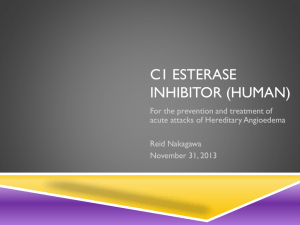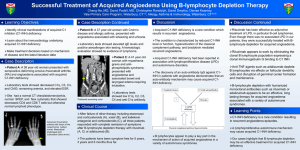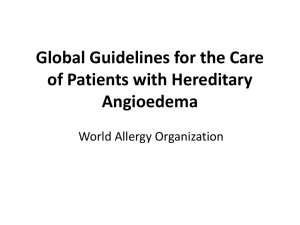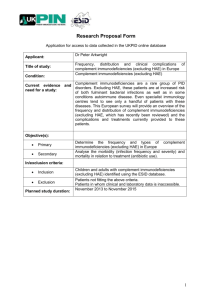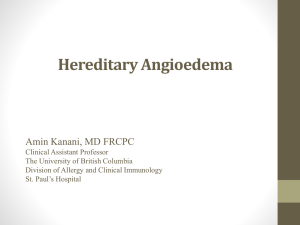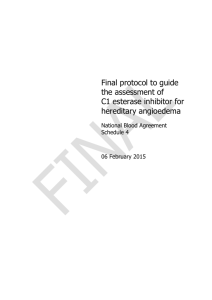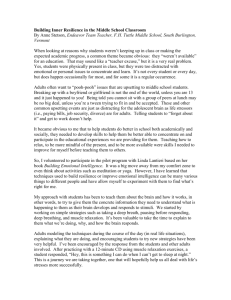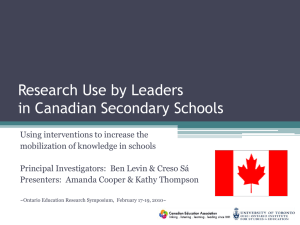Word 48 KB - the Medical Services Advisory Committee
advertisement
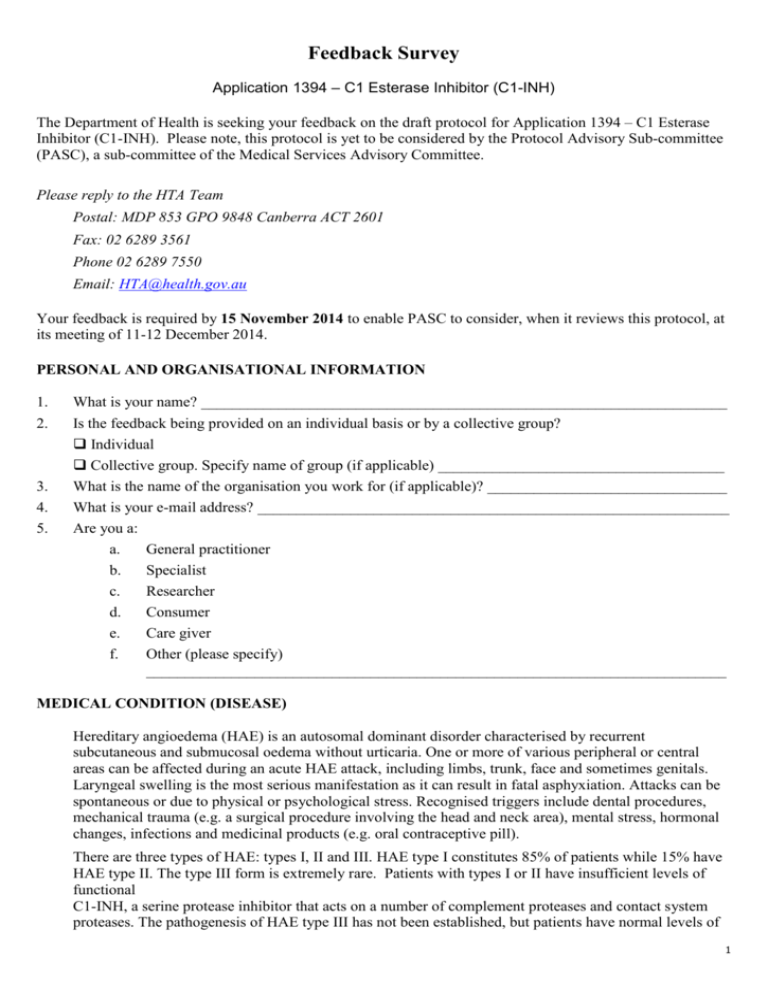
Feedback Survey Application 1394 – C1 Esterase Inhibitor (C1-INH) The Department of Health is seeking your feedback on the draft protocol for Application 1394 – C1 Esterase Inhibitor (C1-INH). Please note, this protocol is yet to be considered by the Protocol Advisory Sub-committee (PASC), a sub-committee of the Medical Services Advisory Committee. Please reply to the HTA Team Postal: MDP 853 GPO 9848 Canberra ACT 2601 Fax: 02 6289 3561 Phone 02 6289 7550 Email: HTA@health.gov.au Your feedback is required by 15 November 2014 to enable PASC to consider, when it reviews this protocol, at its meeting of 11-12 December 2014. PERSONAL AND ORGANISATIONAL INFORMATION 1. 2. 3. 4. 5. What is your name? ____________________________________________________________________ Is the feedback being provided on an individual basis or by a collective group? Individual Collective group. Specify name of group (if applicable) _____________________________________ What is the name of the organisation you work for (if applicable)? _______________________________ What is your e-mail address? _____________________________________________________________ Are you a: a. General practitioner b. Specialist c. Researcher d. Consumer e. Care giver f. Other (please specify) ___________________________________________________________________________ MEDICAL CONDITION (DISEASE) Hereditary angioedema (HAE) is an autosomal dominant disorder characterised by recurrent subcutaneous and submucosal oedema without urticaria. One or more of various peripheral or central areas can be affected during an acute HAE attack, including limbs, trunk, face and sometimes genitals. Laryngeal swelling is the most serious manifestation as it can result in fatal asphyxiation. Attacks can be spontaneous or due to physical or psychological stress. Recognised triggers include dental procedures, mechanical trauma (e.g. a surgical procedure involving the head and neck area), mental stress, hormonal changes, infections and medicinal products (e.g. oral contraceptive pill). There are three types of HAE: types I, II and III. HAE type I constitutes 85% of patients while 15% have HAE type II. The type III form is extremely rare. Patients with types I or II have insufficient levels of functional C1-INH, a serine protease inhibitor that acts on a number of complement proteases and contact system proteases. The pathogenesis of HAE type III has not been established, but patients have normal levels of 1 Feedback Survey functional C1-INH. Consequently C1-INH replacement therapy is indicated for patients with type I or type II HAE only. In acquired angioedema (AAE), also referred to as acquired C1 esterase inhibitor deficiency or acquired C1-INH deficiency, patients have low levels of serum C1-INH. C1-INH protein function and rate of production is normal in these patients but it is catabolised at an increased rate. AAE is distinguished from HAE by low serum C1q levels, an absence of family history and late onset of symptoms, typically in middle age. AAE is commonly associated with lymphoma or other haematological malignancies. The number of patients with AAE is extremely low. PROPOSED INTERVENTION C1-INH concentrate is a serine protease inhibitor purified from pooled human donated plasma. Both proposed C1-INH products are provided as powders to be reconstituted in water and administered intravenously, and have been TGA-approved for the treatment of acute HAE attacks (though one product has also been TGA-approved for prophylactic use, both pre-procedural and routine). C1-INH concentrate is proposed for inclusion on the National Products and Services List (NPSL)1 for the management of patients with a confirmed diagnosis of HAE type I or II. Administration of human C1INH to patients with HAE Type I or II replaces the missing or malfunctioning C1-INH protein resulting in relief from the symptoms of HAE. Additionally, the potential use of C1-INH for HAE patients requiring pre-procedural prophylaxis will be evaluated. The frequency of use for pre-procedural prophylaxis could vary extensively depending on patient circumstances, but is likely to be occasional. Further, the potential use of C1-INH for patients with AAE will also be considered. C1-INH concentrate is clinically indicated in these patients, although larger doses are sometimes required due to rapid consumption. Icatibant is effective at normal doses and may be preferred. Long-term prophylaxis with C1-INH concentrate is extremely rare, with AAE patients usually responding to treatment of the underlying disease. Current C1-INH administration is generally limited to hospital or medical facility settings; however, home or community use may be possible with appropriate training and facilities. CLINICAL NEED AND PUBLIC HEALTH SIGNIFICANCE 1) Describe your experience with the medical condition (disease) and/or proposed intervention relating to the draft protocol? 2) What do you see as the benefits of this proposed intervention for the person involved and/or their family and carers? 3) What do you see as the disadvantages of this proposed intervention for the person involved and/or their family and carers? 1 The NPSL is the list of blood and blood products funded and supplied under Schedule 4 of the National Blood Agreement.. 2 Feedback Survey 4) How do you think a person’s life and that of their family and/or carers can be improved by this proposed intervention? 5) What other benefits can you see from having this proposed intervention publicly funded on the NPSL? The claim for the funding comparison is that listing C1-INH concentrate on the NPSL will provide patient benefits associated with greater access to the intervention for acute attacks and pre-procedural prophylaxis. While there is no clinical or economic claim for the funding comparison for routine prophylaxis, listing C1-INH concentrate on the NPSL is expected to provide patient benefits associated with gaining access to the intervention, for which this subpopulation do not appear to have. INDICATION(S) FOR THE PROPOSED INTERVENTION AND CLINICAL CLAIM Flowchart of existing and potential management with the proposed intervention for this medical condition. Please refer to Figures 1, 2, 4 and 6 in the Draft Protocol for the current clinical management algorithms for acute HAE attacks, pre-procedural prophylaxis and current funding arrangements. Please refer to Figures 3, 5 and 7 for proposed management algorithms for acute attacks, pre-procedural prophylaxis and proposed funding arrangements. 6) Do you agree or disagree with the eligible population for the proposed intervention as specified in the proposed management flowcharts? There are three main indications for the management of HAE: treatment of acute angioedema attacks; pre-procedural (short-term) prophylaxis against angioedema attacks; and routine (long-term) prophylaxis against angioedema attacks. Treatment options differ for each of these separate indications, and for various sub-populations of HAE patients (e.g. paediatric patients, pregnant women). The flowcharts encompass all potential treatment episodes for HAE, and outline all currently available pathways as registered by TGA and endorsed by Australasian Society of Clinical Immunology and Allergy (ASCIA), the peak professional body in the HAE field. Strongly agree Agree Disagree Strongly disagree Why or why not? 7) Do you agree or disagree with the comparator for the proposed intervention as specified in the current management flowchart? 3 Feedback Survey The Protocol nominates three levels of comparison with a variation of comparators in order to comprehensively assess proposed C1-INH products, type of treatment (i.e. acute attack, pre-procedural or routine prophylaxis) and the effect of potential management arrangements: Treatment comparisons (C1-INH concentrate(s) versus each other, icatibant, danazol or tranexamic acid) Setting comparisons (community-administered C1-INH versus hospital-administered C1-INH) Funding comparisons (NPSL-funded versus hospital-funded) Strongly agree Agree Disagree Strongly disagree Why or why not? 8) Do you agree or disagree with the clinical claim (outcomes) made for the proposed intervention? For the treatment comparison in acute attacks, the clinical claim is that C1-INH concentrate is non-inferior to icatibant in efficacy and safety for acute HAE attacks in adults and adolescents (Table 8). This is based on the ASCIA management algorithm which recommends either icatibant or C1-INH concentrate for acute attacks. (For children, and during pregnancy and lactation, the appropriate treatment comparison claim would be that C1-INH concentrate is superior in efficacy and safety to no treatment.) The clinical claim for prophylaxis prior to major procedures in adults and children is that C1-INH concentrate is superior to danazol in efficacy and non-inferior to danazol in safety. This is based on ASCIA advice which favours C1-INH concentrate over danazol for this indication. (For pregnant and lactating women, the appropriate clinical claim would be that C1-INH concentrate is superior in efficacy and safety to tranexamic acid.) The clinical claim for routine prophylaxis is that C1-INH concentrate is superior to no prophylaxis in efficacy, and non-inferior in safety, in adults who have failed oral therapy. (For children , pregnant and lactating women, the appropriate clinical claim would be that C1-INH concentrate is superior in efficacy and safety to tranexamic acid.) Strongly agree Agree Disagree Strongly disagree Why or why not? 9) Have all associated interventions been adequately captured in the flowchart? Yes No If not, please move any misplaced interventions, remove any superfluous intervention, or suggest any missing interventions to indicate how they should be captured on the flowcharts. Please explain the rationale behind each of your modifications. 4 Feedback Survey ADDITIONAL COMMENTS 10) Do you have any additional comments on the proposed intervention and/or medical condition (disease) relating to the proposed intervention? 11) And finally, do you have any comments on this feedback form and process? Please provide comments or suggestions on how this process could be improved. Thank you again for taking the time to provide your valuable feedback. If you experience any problems completing this on-line survey please contact the HTA Team Phone 02 6289 7550 Postal: MDP 853 GPO 9848 Canberra ACT 2601 Fax: 02 6289 3561 Email: HTA@health.gov.au 5
